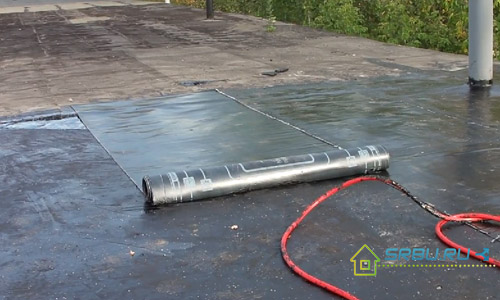Technical characteristics of hydroisol of its brand and scope
One of the important points in any construction is waterproofing. If proper protection of materials and structures from moisture is not provided, the service life of the structure will be short-lived. And soon, the strength of the structure may decline to a critical level. So, if you do not waterproof the concrete structure, after 5-6 years, this same structure will begin to collapse. Corrosion will penetrate concrete a short distance first. And after two dozen years, it will reach a depth of 1.5 meters.
Now there is a huge variety of waterproofing materials that can reliably protect the structure from moisture. However, hydroisol still remains in the first place, the technical characteristics of which allow to increase the service life of materials many times over.

Material characteristics
Hydroisol is a waterproofing and roofing material. It is one of the most economical options for waterproofing. As a rule, this biostable material is delivered in roll form and does not have a cover. The width of the rolls of hydroisol on average is 0.95 m, and the length is 10-20 m. All the necessary requirements for this material contains GOST-7415-86.
If the hydroisol is high-quality, then in the context it should be black. Moreover, the surface is as smooth as possible. The basis of hydroisol is most often fiberglass or fiberglass. On this base, a special high-quality bitumen binder is applied from above and below. Next, a special polymer film is applied to the lower part. The same film can be applied to the top. In addition, coarse mineral sprinkling is often used instead. It is important to note that all the materials used in the basis of hydroisol are completely not subject to decay. And the service life of this building material is 10-12 years.
There are 6 varieties of hydroisol, depending on which components it is made of and for what purpose it is intended. Each type of hydroisol is marked with the letters where:
- X - means that the base of the hydroisol fiberglass;
- T stands for fiberglass base;
- P - means that a polymer film is used as a coating;
- K - means the coating is a coarse-grained topping of a mineral type.
In accordance with these, the following brands exist:
- TKP - designed to form the upper layer of the roof;
- CCI - designed to create the lower layer of the roof and is a universal insulation;
- HKP - can be used as the top layer of roof insulation;
- KhPP - is a waterproofing material of a universal type;
- ECP - used as the top layer of the roof;
- EPP - used as a universal waterproofing material.
Depending on the scope of use, the following two brands of hydroisol are distinguished:
- GI-K - roof type hydroisol intended for the formation of a roofing carpet of flat roofing systems.
- GI-G - is intended for use and waterproofing the underground parts of buildings and structures, as well as various pipelines protecting from corrosion processes.
Depending on the brand of hydroisol, its technical characteristics are also reflected in the table:
| Parameters | GI-K | GI-G |
|---|---|---|
| Moisture absorption in 24 hours,% | 8 | 6 |
| Breaking load in tension in the longitudinal direction, kg.s | 30 | 35 |
| The temperature of the fragility of the impregnating bitumen, 0FROM | - 15 | |
| Softening point of impregnating bitumen, 0FROM. | 47 - 55 | |
| Water resistance at a pressure of 0.05 MPa, min. | 10 | 15 |
Benefits
Hydroisol is distinguished by its quality indicators and affordable price precisely due to the special composition and manufacturing technology.And when using various additional elements, it is possible to influence the characteristics of this material.
So, if you apply hydroisol with mineral sprinkling, the roof will increase resistance to mechanical damage, ultraviolet radiation and other unfavorable natural circumstances. In addition, hydroisol, whose characteristics are very good, can increase the fire resistance of the roof and increase the evaporation of moisture.
This building material withstands a wide range of temperatures - from the lowest to the highest. And the installation of the roof is permissible at a negative temperature. It is also important that with a strong wind and rain, the roof with hydroisol does not “make noise”.
Application area
Hydroisol, the use of which is carried out very widely, can be used in a wide variety of construction sectors. In addition to the most popular application - creating a roof - hydroglass is used in waterproofing foundations, basements, pipes and other problem areas.
This building material is an excellent solution for protecting against destruction of such objects as wells, tunnels, bridges and pools. Often, hydroisol comes to the rescue in the case of underground structures where protection of metal structures from corrosion is necessary. And even with such a great demand, the price of hydroglass glass remains within the framework of affordability - about 340-450 rubles per roll.
To summarize, it can be used for waterproofing the following objects:
- Roofing;
- Foundations;
- Basement walls;
- Overlapping;
- Pools;
- Trunk pipelines;
- Various designs;
Storage conditions
Like many other building materials, hydroisol requires special storage conditions. So, rolls of hydroisol should be stored on specialized pallets in an upright position. Moreover, all of them must be sorted by brand. It is advisable to store this material indoors. If this is so important, it is allowed to keep hydroisol in an open area, but not for long.
It is important to remember that the distance from hydroglass glass to heating appliances should be at least a meter. Moreover, if there is a need, not long-term storage of rolls in two rows is allowed, when the position is vertical. And not long-term storage in an upright position. Moreover, the height should not be more than five rows.
